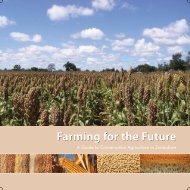Restoring the Soil - Canadian Foodgrains Bank
Restoring the Soil - Canadian Foodgrains Bank
Restoring the Soil - Canadian Foodgrains Bank
Create successful ePaper yourself
Turn your PDF publications into a flip-book with our unique Google optimized e-Paper software.
14Existing Green Manure/Cover Cropping Systems Around The WorldGreen Manure/Cover Crops Systems are WidespreadGm/cc systems are surprisingly common around <strong>the</strong> world. This fact is understandableif we take into account all <strong>the</strong> advantages listed above. During <strong>the</strong> 1990s, <strong>the</strong>NGOs CIDICCO (International Center for Dissemination of Cover Crops) andCOSECHA (Consultants for a Sustainable, Ecological and People-Centered Agriculture)in Central America each compiled a list of known gm/cc systems in about 45countries. The lists were admittedly incomplete. One list included 96 gm/cc systemsand <strong>the</strong> o<strong>the</strong>r 51 systems. 9 Statistically, if we assume that <strong>the</strong> definitions of gm/ccsystems in <strong>the</strong> two lists are identical and that each list was a random sampling of <strong>the</strong>world’s existing systems, a simple ma<strong>the</strong>matical extrapolation indicates that over 500gm/cc systems probably exist around <strong>the</strong> developing world.16. Indonesia. Our lunch at a roadside restaurant,which included three gm/cc species, in a countryin which many agronomists had assured me nogm/ccs were being used.Time and time again, in more than 30developing countries, I have found thatgm/cc systems are thriving where localagronomists were absolutely sure <strong>the</strong>y didnot exist. For instance, Indonesian agronomistsassured me that because Indonesiansdo not eat beans, gm/cc systems wouldnot exist in <strong>the</strong>ir country. However, onmy first day out in <strong>the</strong> field in Indonesia,we ate lunch at a small roadside restaurant(Photo 16). The lunch included threelegumes, all of which we later foundfarmers using as gm/ccs. None of <strong>the</strong>seleguminous foods were actually cooked asbeans, per se: <strong>the</strong> soybeans were served astofu, which was in <strong>the</strong> soup along with green cowpea pods, and <strong>the</strong> mungbeans hadbeen made into some delicious sweet cakes. In <strong>the</strong> following four days, I observed sixdifferent gm/cc systems in just a very small area of sou<strong>the</strong>rn Sumatra.Characteristics of Known Green Manure/Cover Crop SystemsOf <strong>the</strong> known gm/cc systems that have been implemented by farmers around <strong>the</strong>world for at least five years without any subsidies, over 70% were basically developedby smallholder farmers <strong>the</strong>mselves. This fact, perhaps more than anything else, showshow appropriate <strong>the</strong>se systems can be for smallholder farmers, and how interestedsmallholder farmers are in finding and adopting alternatives to both fallowing andchemical fertilizers. (Data on adoption and abandonment of <strong>the</strong>se systems would bea much better indicator of farmer interest, but such figures are not available in mostcases.) It is also surprising that over 100 species of gm/ccs are used, with new onesbeing discovered all <strong>the</strong> time.9Bunch, Roland and Milton Flores, Unpublished lists.
















